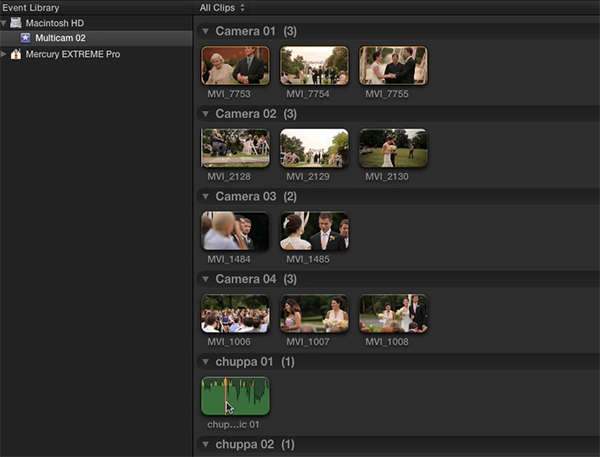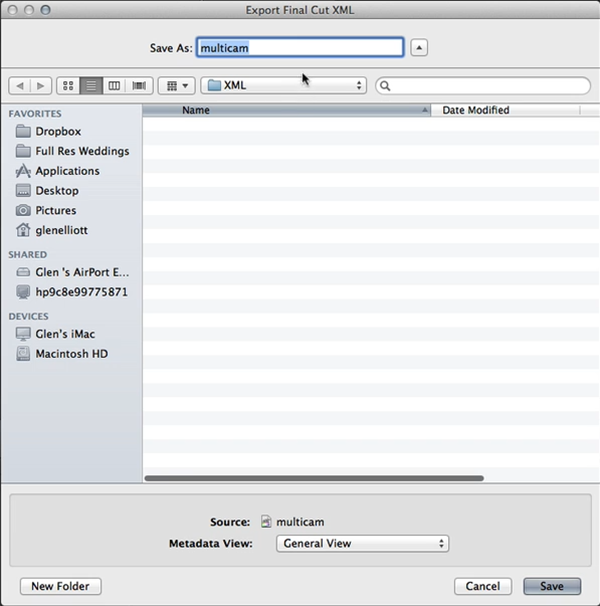Tutorial: Syncing Multicam Footage With PluralEyes 3
In part 2 of our series on multicam editing in Final Cut Pro X, Glen Elliott explains how you can accelerate and streamline the multicam-syncing process in Red Giant's PluralEyes 3.
In this tutorial we’re going to continue talking about multicam editing in Final Cut Pro X. In the previous tutorial we went over how to natively sync your footage in Final Cut Pro, how to make a multi-clip, and how to edit it on the timeline.
In my own edits for Cord3Films, I’ve found that Final Cut Pro’s native ability to sync footage based on a waveform tends to get a little touchy when you have a more complicated project. For example, if you have a project with multiple angles and multiple starts and stops per angle, and multiple audio sources like this project we’ll use in this tutorial, it tends to be a little less reliable.
For that reason, we always use an external source to sync our footage, and that’s a third-party program called PluralEyes, developed by Singular Software, acquired last year by Red Giant Software of Magic Bullet fame, and recently upgraded to v3. We’ll explore how to sync your FCP X footage in PluralEyes 3 in this tutorial.
Preparing the Footage
As you can see in Figure 1 (below), we’ve begun preparing the footage by adding metadata to each camera, because when you bring it in to Final Cut Pro X, Final Cut Pro has no idea what camera it is. So we added metadata to identiy Camera 1, Camera 2, Camera 3, Camera 4. We’ve also done the same thing with our discrete audio sources, because each audio source has to be treated like its own angle, so we highlighted it, went into the Inspector, and added a camera name to all of our audio sources, our off-camera audio.

Figure 1. Our footage, tagged and prepped for syncing
In order to have PluralEyes 3 sync your footage, you need to do a bit more prep. It’s essentially just making a project, dumping all of your footage in there, exporting the XML, and then bringing that into PluralEyes 3. PluralEyes 3 syncs based on XML, so we’re going to take you through the process now.
To begin, we’ll open up a new project. Then we highlight all of our clips from Camera 1, and append them to the timeline. Next we do the same thing with Camera 2, but we have to stack every camera angle--we don’t want them side by side. They have to be separated, so we hit Q make the Camera 2 footage a connected clip (Figure 2, below).

Figure 2. Stacking the clips
Each camera that has more than one file has to be grouped. So the next step is to highlight the files from Camera 2 (in this case, there are 3), and hit Command-G to group them, as shown in Figure 2. We’re going to do the same thing with Camera 3--hit Q, highlight the clips, press Command-G to group them--and the same for Camera 4, and so forth. Next we have to do that with all of our audio angles as well. They got staggered a little bit in the process, so we just have to drag them to make sure they’re stacked on top of one another (Figure 3, below).

Figure 3. Camera angles connected and stacked.
Now we have everything we need to export the XML, which is super-easy. You just choose File > Export XML (Figure 4, below) and name your file.

Figure 4. Exporting the XML.
We’re going to name this one “multicam” (Figure 5, below).

Figure 5. Naming the file.
Related Articles
Here's a look at two workflows for applying film grain to your footage in FCP X using cineLook (with and without Gorilla Grain), first with 4k footage shot with the Blackmagic Production Camera, and then with Cinestyle-flattened DSLR footage.
In our first tutorial on the recently released FCP 10.1, we look at the new Libraries feature, which enhances project and media organization and eases the adjustment for editors transitioning from FCP 7.
This tutorial on Apple Final Cut Pro X takes a closer look at color correction in the Inspector, exploring the Balance Color, Match Color, and Color Mask and Shape Mask features.
This tutorial on Apple Final Cut Pro X inspects the Video Inspector, a context-sensitive area of the FCP X interface that allows you to change settings of various filters and settings, and focuses on making basic but effective color adjustments.
In this video tutorial Glen Elliott of Cord3Films looks at FCP X's Timeline Index which provides innovative options for viewing, navigating, and searching your projects, including three different types of timeline markers and the ability to create a navigable To Do list of editing notes that's indispensable for collaborative workflows.
In this tutorial, Cord3Films' Glen Elliott demonstrates how to mix audio from multiple off-camera sources in a multicam edit in Apple Final Cut Pro X.
Our Final Cut Pro X tutorial series continues with the first installment of a 3-part series on multicam editing in FCP X, addressing the basics like creating a multicam clip and cutting and switching audio and video using the Angle Editor.
Working with compound clips in FCP X is similar to nesting sequences in Final Cut Pro 7. Once you understand how it works, and how changes to compound clips can ripple across projects, it's a powerful feature that you'll find yourself using more and more.
In this tutorial, we'll look at several ways you can use connected storylines to enhance your FCP X edits and mix in cutaways and creative shots in a quick and efficient way.
This tutorial explores advanced editing techniques in FCP X including back-timing your edits, replacing edits and auditioning, top-and-tail editing, extend edits, trim-to-selection edits, keyboard trimming, and the Precision Editor.
The magnetic timeline is one of the major revolutionary changes in Apple Final Cut Pro X, and one of the areas editors struggle with when they're coming from track-based NLEs. In this tutorial we'll break it down and show you how to make it work for you.
In this first installment of our new tutorial series, Glen Elliott demystifies Final Cut Pro X, illustrates its core functions, and focuses on one of the most powerful new features for organizing, accelerating, and streamlining your edits: metadata keyword tagging.